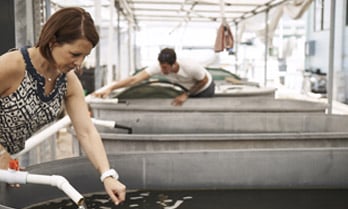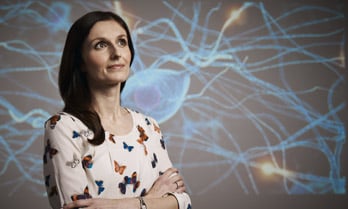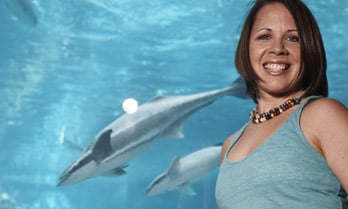Dr Marie-Liesse Asselin-Labat, Walter and Eliza Hall Institute of Medical Research
01 September 2011
How does breast cancer start?
Dr Marie-Liesse Asselin-Labat wants to know why. If she can solve this mystery, her work will open up opportunities for new drugs and treatments. Her achievements to date suggest that she is well placed to succeed.
In 2006 she was part of the Walter and Eliza Hall Institute of Medical Research team that received global attention for its discovery of breast stem cells – a significant step in understanding how breast cancer starts. Marie-Liesse built on this finding with a series of papers exploring how these cells develop and are influenced by oestrogen and other steroids.
Her L’Oréal For Women in Science Fellowship allowed her to develop her career as an independent researcher and to assist in the care of her two young boys.
Qualifications
2004 – PhD (Molecular and Cellular Biology), University Paris XI, France
2001 – Doctor in Pharmacy, School of Pharmacy, University of Nantes, France
2000 – Master in Clinical and Experimental Pharmacology, University Paris XI, France
Career highlights, awards, fellowships, grants
2010-2015 – Queen Elizabeth II Australian Research Council Fellowship
2009-2011 – Cancer Australia/National Breast Cancer Foundation grant: Role of the GATA-3 transcription factor as a tumour suppressor and potential therapeutic target in breast cancer, co-investigator on grant awarded to by Jane Visvader, Geoff Lindeman, Stephen Fox and Marie-Liesse Asselin-Labat
2008-present – Senior Research Officer, The Walter and Eliza Hall Institute of Medical Research, Victorian Breast Cancer Research Consortium, Melbourne, Australia
2008-2009 – Australian Research Council post-doctoral fellowship
2007-2008 – Australian Research Council post-doctoral Fellowship
2007-2009 – Cancer Council Victoria venture grant: Developing lead compounds to target breast cancer by specific inhibition of the LMO4 oncogene, co-investigator on grant awarded to Jane Visvader, Geoff Lindeman, Marie-Liesse Asselin-Labat, Keith Watson and Ian Street
2007-2009 – National Health and Medical Research Council Program grant: Roles of impaired apoptosis and differentiation in tumourigenesis and therapy, co-associate investigator on grant awarded to Jerry Adams
2007 – Lorne Cancer Conference Poster Prize
2007 – International Society for Stem Cell Research Annual Meeting travel grant
2006 – Institut national de la santé et de la recherche médicale/National Health and Medical Research Council postdoctoral fellowship (exchange program)
2005 – Fondation pour la Recherche Medicale post-doctoral fellowship
2004-2008 – Research officer, The Walter and Eliza Hall Institute of Medical Research, Victorian Breast Cancer Research Consortium, Melbourne, Australia
2000 – Research Assistant, Laboratoires UPSA, Paris
Research highlights
- Seven presentations at Australian and international conferences and institutions, including two invited conference presentations
- Twenty publications, including seven first-author journal articles, three reviews and one book chapter
- Actively involved in editorial and peer review for a variety of journals and grants
Top five publications
Asselin-Labat ML, Vaillant F, Sheridan JM, Pal B, Wu D, Simpson ER, Yasuda H, Smyth GK, Martin TJ, Lindeman GJ, Visvader JE. Control of mammary stem cell function by steroid hormone signalling. Nature. 2010 Apr 11 (advanced online). (IF 31.4)
Asselin-Labat ML *, Sutherland KD*, Barker H, Thomas R, Shackleton M, Forrest NC, Hartley L, Robb L, Grosveld FG, van der Wees J, Lindeman GJ, Visvader JE. . (2007) Gata-3 is an essential regulator of mammary-gland morphogenesis and luminal-cell differentiation. Nat Cell Biol. Feb;9(2):201-9. *: Equal first author (IF 17.8, cited x94)
Vaillant F*, Asselin-Labat ML *, Shackleton M, Forrest N, Lindeman GJ and Visvader JE. The mammary progenitor marker CD61/β3 integrin identifies cancer stem cells in mouse models of mammary tumorigenesis.Cancer Research. 2008 Oct 1;68(19):7711-7 .*: Equal first author. (IF 7.5 , cited x19)
Asselin-Labat ML, Shackleton M, Stingl J, Vaillant F,. Forrest NC, Eaves CJ, Visvader JE, Lindeman GJ (2006). Steroid hormone receptor status of mouse mammary stem cells. J Natl Cancer Inst. Jul 19;98(14):1011-4. (IF 15.6, cited x73)
Asselin-Labat ML, David M, Biola-Vidamment A, Lecoeuche D, Zennaro MC, Bertoglio J and Pallardy M. (2004). GILZ, a new target for the transcription factor FoxO3, protects T lymphocytes from interleukin-2 withdrawal-induced apoptosis. Blood 104, 215-23. (IF 9.8, cited x41)




